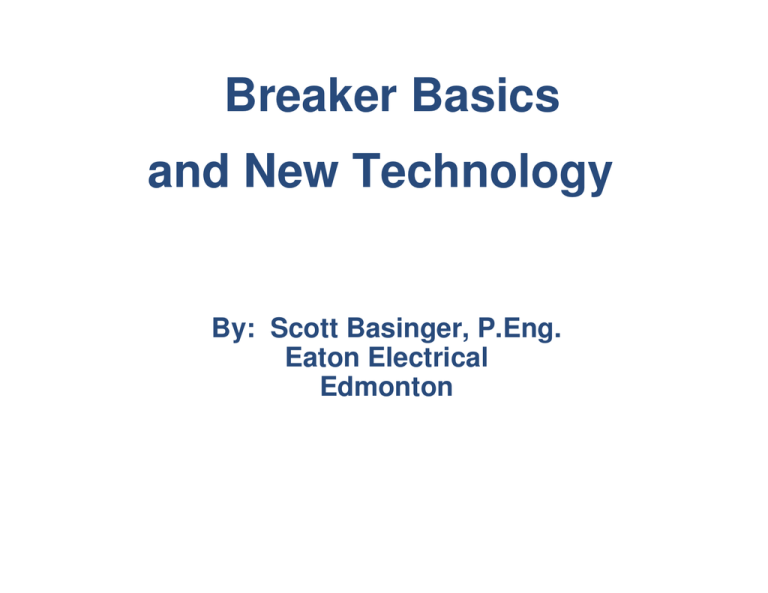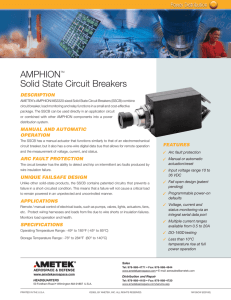Breaker Basics and New Technology
advertisement

Breaker Basics and New Technology By: Scott Basinger, P.Eng. Eaton Electrical Edmonton Purpose Circuit Breaker History First Developed at the request of Fire Inspection Authorities in the US in the 1920’s to provide better protection against fires. These fires were caused by users of electrical power who were bridging plug fuses with pennies or replacing fuses with ratings too high for the wires installed. Modern breaker design was primarily made possible by the development of the arc chute by Dr. Slepian of Westinghouse. Breaker Classifications MCCB – Molded Case Circuit Breaker This presentation is primarily about MCCB’s ICCB – Insulated Case Circuit Breaker Same standard as MCCB’s with some features found in LVPCB’s LVPCB – Low Voltage Power Circuit Breaker Marking and Terminology Molded Case Circuit Breakers Marking and Terminology Voltage Rating RMS AC voltage or DC Voltage at which the breaker is designed to operate. Breaker voltage markings on MCCB’s are significant and relate to the systems they may be used in. “Straight ratings” – 600V, 480V, 240V “Slash ratings” – 600Y/347V, 120/240V Current Rating RMS AC current or DC current rating which the breaker will carry continuously in open air. Molded Case Circuit Breakers Marking and Terminology Ambient Temperature Temperature of the air surrounding the breaker itself Not necessarily room temperature Interrupting Rating Highest RMS symmetrical AC (or DC ) current which a breaker is required to interrupt under specified test conditions. Switching Duty Rated Breakers marked with SWD for breakers tested to switch florescent lighting loads on a regular basis. 100% Rated Breakers Breakers must be marked specifically for 100% continuous operation in enclosures. All others are 80%. Breaker Elements Circuit Breaker Components Arc Extinguisher / “Arc Chutes” • Contact parting creates arc • Magnetic field pulls arc into arc extinguisher • Arc divided and cooled by steel plates • Arc extinguishes, opening circuit Circuit Breaker Components Contact Assemblies Circuit Breaker Components Overload Protection • Bimetallic element • Bimetal in series with connected cable • Thermal “memory” Circuit Breaker Components Overload Protection Circuit Breaker Components Short-Circuit Protection Circuit Breaker Components Short-Circuit Protection Circuit Breaker Components Thermal Magnetic Protection Circuit Breaker Components Electronic Circuit Breakers Circuit Breaker Components Electronic Circuit Breakers Thermal Long Time Pickup Long Time Delay Time Magnetic Short Time Pickup Short Time Delay Instantaneous Pickup Ground LSI Ground Fault Pickup Ground Fault Delay Time Ground Electronic Trip Units Trip Functions THERMAL Curve Shaping 1. Long Time Pickup (80%-160%) 2. Long Time Delay The Basis for Coordination MAGNETIC 3. Short Time Pickup (400% - 1000%) 4A. Short Time Delay Flat Response 4B. Short Time Delay I2t Response (0.1-0.5s) 5. Instantaneous / Fixed Inst. Override (500%-1500%) GROUND FAULT Current in Multiples of Plug In Rating 6. Ground Fault Pickup 7A. Ground Fault Delay Flat Response 7B. Ground Fault Delay I2t Response Auxiliary Switch Consists of contacts that are activated by the opening and closing of breaker. Bell Alarm/Lockout Switch Activated only when a breaker trips due to a fault.....not when breaker is turned manually off and on. Shunt Trip Used to trip breaker from remote location Consists of a momentarily rated solenoid Must be energized by control power source Notes: NOT to be used with maintained contacts. NOT to be used as a circuit interlock. Undervoltage Release Trips breaker when voltage falls below 35 to 70% of solenoid rating. Three types available: automatic reset handle reset electric reset Breaker cannot be turned on until voltage returns to 85% of normal Note: NOT to be used as a circuit interlock Standard Requirements MCCB – Standard Requirements Tests covered by C22.2 No. 5.1 US Manufacturers also comply to UL489 Quick Overview of Tests: 1.2 m of cable on load side of breaker – helps test wires for pull-out and to test for breakage of the MCCB case from stress Calibration test Required to interrupt a number of overload and fault conditions, be reset, and be put back into service. Dielectric withstand test (2 x Rated Voltage + 1000V) Fault test 2 operations: open and close-open (optional) IER / Series Rating tests in rated enclosures Unusual Operating Conditions MCCB - Unusual Operating Conditions High Ambient Temperatures > 40o C De-rate Thermal Magnetic Breakers Calibrated @ 40o C in accordance with Manufacturer’s Tables (note: some electronic trip units do not require de-rating) Some manufacturers have special use breakers suitable for 50C “Rule of Thumb” from IEEE Std 1015-1997 “Blue Book” for MCCB’s (assume T1=T2 = 90C): I 2 = I 1 (T 2 − A2) /(T 1 − A1) MCCB - Unusual Operating Conditions Low Temperatures MCCB - Unusual Operating Conditions Very Low Ambient Temperatures Ref: IEEE Standard 1015-1997 Blue Book MCCB and ICCB’s –5C Ratings from one manufacturer: Environment Duty –20C -> 50C (CSA listed) Typically –5C -> 40C Change of grease required to perform at low temperatures represents a material change to the breaker. Use of breakers below temperatures listed by the manufacturer may require special consideration, such as the use of a thermostat / space heater in the enclosure. Refer to manufacturer. MCCB - Unusual Operating Conditions High X/R Molded case breakers and Power Circuit Breakers are evaluated differently for X/R If System X/R > Standard X/R, no de-rating is required. Power Breakers are tested with X/R ratio of 6.6 MCCB’s are tested with varying X/R : Tested X/R varies from 6.6 to 1.75 depending on interrupting rating. Can obtain multiplication factors for short circuit interrupting rating and ranges in IEEE Blue Book Harmonics May affect the accuracy of “Peak Sensing” Electronic Trip Units / Relays. Modern protective relays that use RMS sensing typically do not have this issue. MCCB - Unusual Operating Conditions High Altitude > 6000 Ft Dielectric is air, which is thinner at high altitude. Affects both the Voltage and Current Rating. IC usually unchanged if Voltage is de-rated. One Manufacturer: − Typ. -3% V per 1000 ft over 6000 with IC remaining as published. − Typ. De-rate current equal to a 3C increase in Ambient per 1000 ft over 6000 (in addition to standard 80% derating) − Always use manufacturer tables. MCCB - Unusual Operating Conditions Moisture High Humidity is usually remedied by space heaters / thermostat to prevent condensation. Incorrect installation of panel. Sample – breaker from outdoor panel that was allowing water ingress. Common Errors MCCB – Common Application Errors Incorrect Interrupting Rating Fault study not completed. Add breaker with one of lower interrupting rating. Interrupting rating not de-rated for altitude > 6000 ft. MCCB – Common Application Errors Incorrect Voltage Rating Consider the Y –Resistance grounded system below Error is using breakers that are slash-rated ie: 347Y/600V vs straight-rated ie: 600V breakers Further IEEE recommendations in Std. 141-1993 [B4] MCCB – Common Application Errors Incorrect Voltage Rating Grounded B-phase system requires special attention. A L-G fault, at full L-L voltage would be interrupted by a single pole of a MCCB. There is a single-pole test at L-L in C22.2 No 5.1, but at reduced interrupting rating. UL listed breakers suitable for use will be marked “1ph3ph”, otherwise refer to manufacturer. MCCB – Common Application Errors Incorrect current rating Breakers, unless noted as “100% Rated” are 80% rated in enclosures. May cause nuisance tripping. MCCB – Common Application Errors Use of “Refurbished” molded case circuit breakers. Better Protection MCCB – Enhanced Protection Options Breakers and Relaying Only simple provisions (shunt trip, trip coil) are required to trip a breaker safely. Allows many enhanced protection options via external or internal breaker relaying. MCCB – Enhanced Protection Options Ground Fault Relaying Ground faults are usually less than 38% of fault level and are extremely damaging to downstream equipment. The faster these are cleared the damage is greatly reduced. “New” MCCB Technology / Advanced Applications Series Ratings (IER) “New” MCCB Technology / Advanced Applications Selectively Coordinated Systems Selectively Coordinated Systems Zone selective interlocking is a means by which two or more selectively coordinated trip devices can communicate and alter their preset tripping mode to provide faster response time for upstream fault conditions. This allows the nearest upstream breaker from the faulted zone to clear the circuit in the shortest time possible and reduce the system damage level potential. Selectively Coordinated Systems LVPCB’s with MCCB’s • Full discrimination • Optimum continuity of service • Short Time Delay - Allows the main breaker to remain closed for up to 30 cycles, but • Subjects equipment to high mechanical and thermal stresses • Higher equipment cost • Larger equipment size • Greater arc flash hazard risks • Short Time Delay Co-Ordination Benefit Example 1 Selective Co-Ordination Zone Selective and Arc Flash Unless a Low Voltage Power Circuit Breaker operates in the Instantaneous trip mode, the arc flash energy values will typically require Category 3 PPE or greater. The example on the next page illustrates this. Zone Selectively Interlocked Breakers provide significantly lower Arc Flash energy values: Refer to your manufacturer for test data for arc flash using Selective Co-Ordination. During maintenance it is usually recommended to temporarily adjust the Instantaneous and Ground Fault (if available) trip settings to their lowest value. Zone Selective Interlock Example M1 SD= 0.5S F1 F2 SD= 0.3S Without ZSI = 0.5 S: 43.7 Cal/cm2 Greater than Cat. 4 PPE DANGER! 35kA fault current X F3 SD= 0.3S SD= 0.3S With ZSI = 0.08 S: 7.0 Cal/cm2 Cat. 2 PPE FR Shirt & Pants Home Safety “New” MCCB Technology / Advanced Applications Arc Fault Circuit Interrupters – Home Safety The CEC and AFCI CEC 26-722(f): Branch circuits that supply receptacles installed in sleeping facilities of a dwelling unit shall be protected by an arc-fault circuit interrupter. 26-722(g): For the purposes of paragraph (f), an arc-fault circuit interrupter means a device intended to provide protection from the effects of arc-faults by recognizing characteristics unique to arcing and functioning to deenergize the circuit when an arc-fault is detected. Causes of Residential Fires 160,000 Smoking 140,000 120,000 Cooking 100,000 80,000 Heating 60,000 40,000 Arson 20,000 Source: NFPA 97 19 95 19 93 19 91 19 89 19 19 87 0 Electrical Distribution Where Do Electrical Fires Start? Study conducted by NEMA task force Where Do Electrical Fires Start? Zone Zone 00 2% 2% Zone Zone 33 50% 50% Zone Zone 11 36% 36% Zone Zone 22 12% 12% Why Do Electrical Fires Start? Why Do Electrical Fires Start? Homeowner Abuse: The Results: Why didn’t the Standard Breaker Trip? Current breakers offer three elements of protection Thermal Protects wire from overheating due to low level current overloads requires 3+ seconds of overcurrent to move the bimetal Magnetic Protects wire from high short circuit currents - utilizes an electromagnet Ground Fault (optional) Senses unbalanced line to neutral loads 5mA and 30mA sensitivity Typical Arc Current Waveform Typical current waveforms observed when a carbon-steel blade cuts through 16 AWG SPT-2 cord. The available current is 100A. A Two Tier Challenge Required Innovation – – Technical Challenge – – Detect Arcing Faults De-energize the effected circuit Determine unsafe versus acceptable arcing Avoid unnecessary breaker tripping AFCI Electronics The challenge has been to design electronic circuitry that recognizes arc signatures. Types of Arcing Faults Series Arc Fault (undetectable by other means) Parallel Arc Fault (undetectable by other means) Arcing Faults to Ground (also GFCI) Series Arcing L1 Parallel Arcing (Line-Neutral) N Parallel Arcing (Line-Gnd) Gnd Equipment Grounding Conductor Load Arc Fault Demo Questions?




